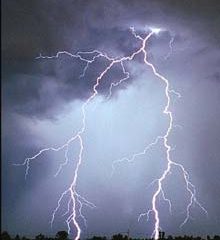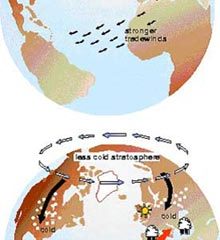Earth Sciences
Earth Sciences (also referred to as Geosciences), which deals with basic issues surrounding our planet, plays a vital role in the area of energy and raw materials supply.
Earth Sciences comprises subjects such as geology, geography, geological informatics, paleontology, mineralogy, petrography, crystallography, geophysics, geodesy, glaciology, cartography, photogrammetry, meteorology and seismology, early-warning systems, earthquake research and polar research.

NASA study finds increasing solar trend that can change climate
Since the late 1970s, the amount of solar radiation the sun emits, during times of quiet sunspot activity, has increased by nearly .05 percent per decade, according to a NASA funded study.
“This trend is important because, if sustained over many decades, it could cause significant climate change,” said Richard Willson, a researcher affiliated with NASA’s Goddard Institute for Space Studies and Columbia University’s Earth Institute, New York. He is the lead author of the study rece

Study shows lightning adds to ozone level
Lightning may be Mother Nature’s greatest show on Earth, but scientists now know it can produce significant amounts of ozone and other gases that affect air chemistry.
Researcher Renyi Zhang of Texas A&M University helped lead a study on the impact of lightning, and the results are surprising: Lightning can be responsible for as much as 90 percent of the nitrogen oxides in the summer and at the same time increase ozone levels as much as 30 percent in the free troposphere, the area that

15-foot hypodermic needles provide evidence for vast oceanic crustal biosphere
Teeming with heat-loving microbes, samples of fluid drawn from the crustal rocks that make up most of the Earth’s seafloor are providing the best evidence yet to support the controversial assertion that life is widespread within oceanic crust, according to H. Paul Johnson, a University of Washington oceanographer. Johnson is lead author of a report being published March 25 in the American Geophysical Union’s publication Eos about a National Science Foundation-funded expedition he led last s

Upside-down underwater telescope to study visitors from space
Scientists from the Universities of Sheffield and Leeds will soon be able to study some of the most elusive particles known to man, thanks to a giant telescope under the sea that looks down towards the centre of the Earth rather than up into the sky.
Together with fellow scientists from across Europe they are building a telescope 2400m (one and a half miles) under the Mediterranean Sea to detect neutrinos. These tiny elementary particles hardly exist at all, having no charge and almost no m

Study Explains "Last Gasp Of Ice Age", Says U Of T Prof
The melting of an Antarctic ice sheet roughly 14,000 years ago triggered a period of warming in Europe that marked the beginning of the end of the Earth’s last ice age, says a new study.
A paper in the March 14 issue of the journal Science suggests that a catastrophic collapse of an Antarctic ice sheet dumped roughly a million cubic litres per second of freshwater into the southern oceans, changing the climate thousands of kilometres to the north and ushering in a dramatic climate shift kn

The 1991 Mt. Pinatubo Eruption Provides a Natural Test for the Influence of Arctic Circulation onClimate
A recent NASA-funded study has linked the 1991 eruption of the Mount Pinatubo to a strengthening of a climate pattern called the Arctic Oscillation. For two years following the volcanic eruption, the Arctic Oscillation caused winter warming over land areas in the high and middle latitudes of the Northern Hemisphere, despite a cooling effect from volcanic particles that blocked sunlight.
One mission of NASA’s Earth Science Enterprise, which funded this research, is to better understand how th